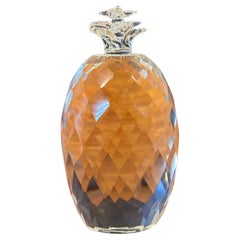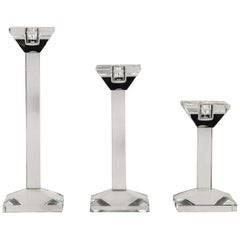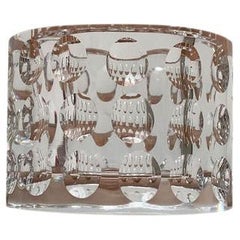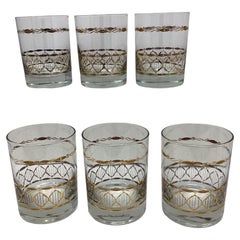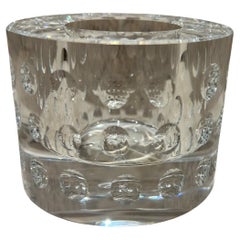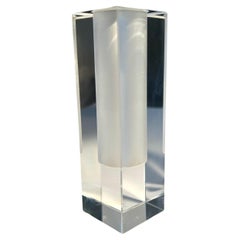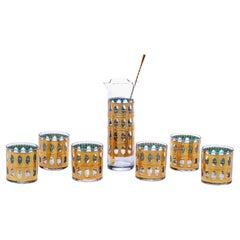Oleg Cassini Furniture
to
1
8
1
9
4
1
1
9
1
4
1
1
6
6
3
1
1
5
5
2
1
1
9
9
9
45
8,810
3,916
2,535
2,229
Creator: Oleg Cassini
Hollywood Regency Crystal Pineapple Paperweight by Oleg Cassini
By Oleg Cassini
Located in San Diego, CA
A very nice Hollywood Regency crystal pineapple paperweight by Oleg Cassini, circa 1980s. The piece is in very good vintage condition with no chi...
Category
Late 20th Century American Hollywood Regency Oleg Cassini Furniture
Materials
Crystal
Set of 3 Crystal Candlesticks by Oleg Cassini
By Oleg Cassini
Located in New York, NY
Set of three (3) crytsal candlesticks, signed Oleg Cassini. USA, circa 1970.
Dimensions:
Base: 3.25 inches x 3.25 inches
Height: 6 inches, 8 inches, 10 inches (respectively)
Category
1970s American Vintage Oleg Cassini Furniture
Materials
Crystal
Vintage Glass Crystal Candleholder by Oleg Cassini
By Oleg Cassini
Located in Hamburg, DE
Vintage Glass Crystal Candleholder by Oleg Cassini, in Very Good conditions. Designed 1970 to 1979 This piece has an attribution mark.
Additional information:
Materials: Glass
Item ...
Category
20th Century Oleg Cassini Furniture
Materials
Glass
Set 6 Oleg Cassini Double Rocks Glasses
By Oleg Cassini
Located in Chapel Hill, NC
Set 6 Oleg Cassini Double Rocks Glasses. Oleg Cassini was the designer for Jackie Kennedy.
Category
1980s American Mid-Century Modern Vintage Oleg Cassini Furniture
Materials
Glass
$495 / set
Oleg Cassini Crystal Candle Holder Bubble Glass Votive
By Oleg Cassini
Located in Chula Vista, CA
AMBIANIC presents
Oleg Cassini Crystal Bubble Glass Votive Candle Holder
Art Glass Modern Crystal Votive
3 x 3
Original vintage
Refer to images pr...
Category
Late 20th Century Mid-Century Modern Oleg Cassini Furniture
Materials
Crystal
Crystal Rectangular Bud Vase by Oleg Cassini
By Oleg Cassini
Located in Los Angeles, CA
A stunning Rectangular Crystal Bud Vase by Oleg Cassini. The vase refracts light beautifully and the portion of the vase that holds water is frosted on the inside.
An elegant pie...
Category
20th Century French Mid-Century Modern Oleg Cassini Furniture
Materials
Crystal
Pair of Oleg Cassini Crystal Stacked Cube Candleholders
By Oleg Cassini
Located in Pasadena, TX
This is a nice pair of crystal Candleholders. They're sculpted into stacked cubes giving them a step pattern. They're engraved on the bottom by the artis...
Category
20th Century American Mid-Century Modern Oleg Cassini Furniture
Materials
Crystal
White Bunny Drawing by Oleg Cassini for Playboy October 1979, Signed
By Oleg Cassini
Located in Brooklyn, NY
White Bunny Drawing by Oleg Cassini for Playboy October 1979, Signed.
Illustration of a woman wearing a white body suit, choker, and hat. Signed by Oleg Cassini. Notice the body suit is in the shape of the head of a bunny with clever use of the 'whiskers'.
Approximate Measurements: Length: 11" Width: 14"
Property from the Collection of Steven Rosengard, Chicago, Illinois
This original drawing was commissioned by Playboy and included in the October 1979 issue of Playboy Magazine (pages 225-227) in a feature that included works from designers such as Bill Blass, Oleg Cassini, Edith Head, Fernando Sanchez, and Monika Tilley, among others, who create their versions of the Playboy bunny costume. Candace Collins can be seen modeling some of the designs in the feature.
Oleg Cassini is an icon of twentieth-century fashion. Though born to Russian aristocracy and raised in Italy, he built a fashion empire that was unmistakably American. Cassini is perhaps best known for the hundreds of designs he created for First Lady Jacqueline Kennedy (see images 4-8), but his achievements as a collector, connoisseur, and quintessential twentieth-century man go far beyond Camelot.
In 1913, Oleg Cassini was born in Paris to the Russian diplomat Count Alexander Loiewski and Countess Marguerite Cassini, a Russian aristocrat of Italian ancestry who also had an interesting link to America. The daughter of Count Arthur Cassini, Russian Ambassador to the United States during the McKinley and Roosevelt administrations, Marguerite dazzled turn-of-the-century Washington as her father’s official hostess and left her mark on the capital city. Stationed in Denmark when the Russian Revolution toppled the czar, Ambassador Cassini and family were exiled to Switzerland before settling in Florence, Italy, where young Oleg was raised. A true Renaissance man, he spoke Russian, French, and Danish before adding Italian and English; he studied medieval and modern European military history and costume and learned to draw; he learned horseback riding, fencing, and the art of chivalry; and, most importantly, he came to understand the struggles of the Russian titled class and other European aristocrats in the wake of the Russian Revolution and World War I.
Countess Cassini started a successful fashion business in Florence, and soon the talented young Oleg was sent to Paris to sketch the latest collections for recreation in Italy. In Rome in his early 20s, Cassini created fashions for high society women and designed for a few films, which planted the seed for his move to Hollywood. The drive to reinvent himself brought Cassini to America in the 1930s; in his autobiography he describes arriving nearly penniless in mid-Depression New York City where his title as an exiled Russian Count meant even less than in war-devastated Europe. Down and out, Cassini struggled for employment, having sketching skills but no knowledge of the wholesale trade required for survival in Manhattan’s Seventh Avenue fashion district. However, he excelled at making connections, and Cassini slowly entered New York society. He was soon joined by younger brother Igor (who had studied in America and travelled with the young Emilio Pucci) and his parents, the once-dazzling Countess and his father, the displaced diplomat still loyal to Russia. The family settled in Washington, D.C., and Igor worked his way up the Hearst newspaper chain to become the famous society columnist Cholly Knickerbocker.
In New York, Oleg Cassini married the troubled socialite Merry Fahrney (who would go on to marry eight times), but the marriage ended in scandal for Oleg, and he decided to follow his original intention and head for Hollywood. Despite initial difficulties, Cassini gained access to Hollywood’s elite (partially through his skills on the tennis court), and was soon hired as a designer at Paramount Pictures alongside the redoubtable Edith Head. In her 1941 film debut I Wanted Wings, Veronica Lake wore a memorable Cassini design. That same year, Cassini met and married the newest young Hollywood star on the scene, the beautiful 20th Century Fox–talent Gene Tierney.
With the outbreak of World War II, Cassini enlisted in the Coast Guard but was transferred to the U.S. Army Cavalry which allowed officers of foreign birth. He attended basic training at Fort Riley, Kansas, and the horsemanship he learned as a boy served him greatly. He attended Officer Candidate School and reached the rank of First Lieutenant (he also became an American citizen at this time, losing his title of Count). Cassini spent several years posted at Fort Riley, where Tierney joined him before he landed a convenient military post in Hollywood. As Tierney’s career thrived (she played the title role in Otto Preminger’s Laura in 1944), she was able to assert her influence over 20th Century Fox’s head Daryl Zanuck, who hired Cassini as designer for Tierney on her 1946 film The Razor’s Edge, which proved to be a brilliant showcase for his talents. The pair separated the same year and, again seeking reinvention, Cassini re-established himself in New York City as a fashion designer. By 1950, the Oleg Cassini label was born.
Combining his knowledge of Old World and modern Europe, Hollywood, the tennis courts of Palm Beach and Newport, and of course, New York City, Oleg Cassini invented a new brand of fashion that was distinctly American and of its moment. For his first collection, Cassini took to the stage, narrating the looks and imbuing the scene with his personality, unusual in an industry where the designers typically remained backstage and the models were called by number over a PA. The first collection was a smash — the president of Lord & Taylor devoted all of their storefront windows to his designs — and by 1955 sales had reached $5,000,000. Oleg Cassini’s career had turned a very positive corner.
Cassini spent the early 1950s traversing the country, personally selling his collections to department stores in the interior, something his predecessors had never done, and moving between the Hollywood and New York scenes. Cassini’s brother Igor coined the term “the Jet Set” for this generation that constantly flew from New York to Los Angeles (then a ten-hour flight), Las Vegas, Paris, Rome, and the Riviera. In 1954, Cassini set out to woo Grace Kelly and sent her roses every day. The two were briefly engaged before her marriage to Prince Rainier of Monaco.
In December 1960, Cassini’s career-defining opportunity came when he was chosen by Jacqueline Kennedy to design her fashions for the White House. Cassini had long known Joe Kennedy and his war-hero son John, and had first met Jacqueline Bouvier before her marriage in the early 1950s. Invited by President-Elect Kennedy to meet Jacqueline at Georgetown Hospital (she had just given birth to son John Jr.) to present to her drawings of potential dresses and First Lady looks, Cassini worked furiously to prepare a new line for the First Lady. Mrs. Kennedy had always had her clothes made by the top French couturiers of the day, but for the White House she wanted an American designer. Cassini wrote in his autobiography that he told the First Lady: “‘You have an opportunity here,’ I said, ‘for an American Versailles.’ She understood completely what I was trying to communicate; she began to talk excitedly about the need to create an entirely new atmosphere at the White House. She wanted it to become the social and intellectual capital of the nation” (Oleg Cassini, In My Own Fashion, 1987, p. 327).
Mrs. Kennedy loved Cassini’s design for a gown to wear to the Inaugural Gala (she had already ordered a dress from Bergdorf’s for the Inaugural Ball), and Cassini was selected as the First Lady’s designer and was soon dubbed the “Secretary of Style.” From 1960 to 1963, Oleg Cassini would design over 300 items for Mrs. Kennedy, creating the “Jackie Look” that contributed not only to a fashion revolution but also the dawn of a new age. Cassini wrote that “Jackie played a very active role in the selection of her clothes. She loved brilliant colors — pistachio, hot pink, yellow, and white among others. Her sense of style was very precise; she would make editorial comments on the sketches I sent her. She always knew exactly what she wanted; her taste was excellent” (Oleg Cassini, In My Own Fashion, 1987, p. 334).
After the Camelot years, Cassini’s business flourished and grew into a major industry; his name appeared on everything from couture to tennis-, sport-, and swimwear, car interiors, housewares, and perfume. He collected beautiful and rare artwork, arms and armor, and antique furniture, and lived the lifestyle projected by his image. From this period onward, Cassini also came to live in important homes. Of his Gothic Gramercy Park townhouse on Manhattan’s 19th Street he would write imaginatively, “I walked into the foyer and immediately fell in love. It was a place unlike any other in New York, a sixteenth-century Dutch house transported brick by brick from Europe by the Wells Fargo family in the early twentieth century. There was a vaulted, twenty-foot ceiling in the living room, leaded windows, elegantly carved wood paneling...
Category
Mid-20th Century Italian Oleg Cassini Furniture
Materials
Paper
$2,408 Sale Price
30% Off
Set of Three Clear Crystal Tapered Candlesticks
By Oleg Cassini
Located in Queens, NY
Set of 3 clear crystal taper candlesticks with square bases, tapered bodies, and wide, square tops in two heights (2 Small 6" H, 1 large 8" H) (Oleg Cassini) (PRICED AS SET).
Category
20th Century American Modern Oleg Cassini Furniture
Materials
Crystal
Related Items
Mid-Century Modern Culver Gold Plated Cocktail Mixer & Rocks Glasses Set c. 1965
By Culver Ltd.
Located in Saint Louis, MO
Sexy Mid-Century Modern cocktail mixer and matching rocks glasses set with 22k gold plating produced by Culver in the late 1960s. This set is in grea...
Category
1960s American Mid-Century Modern Vintage Oleg Cassini Furniture
Materials
Gold Plate
$2,000 / set
H 9.25 in Dm 2.75 in
Set of 12 Deborah Ehrlich Simple Crystal Rocks Glasses, Handblown in Sweden
By Deborah Ehrlich
Located in Accord, NY
Launched with Takashimaya in 1999, these handblown crystal rocks glasses have become a modern classic. Each Deborah Ehrlich piece is designed for t...
Category
21st Century and Contemporary American Modern Oleg Cassini Furniture
Materials
Crystal
$840 / set
H 2.5 in Dm 3 in
Vintage Cera Glass Set of 8 Dow-Jones Industrial Average 1958-68 Rocks Glasses
By Cera
Located in St. Louis, MO
Set of 8 vintage Ceraglass, 10 years of Dow-Jones Industrial Average 1958-68 rocks glasses. Printed in black and white with 22k ticker tape, with highlight...
Category
1960s American Mid-Century Modern Vintage Oleg Cassini Furniture
Materials
Glass
$750 / set
H 3.38 in Dm 3.19 in
Crystal Votive Candle Holders by Goran Wärff for Orrefors, Mid-Century Modern
By Orrefors
Located in Bochum, NRW
Crystal Votive Candle Holders by Goran Wärff for Orrefors, Mid-Century Modern.
Pair of crystal votive candleholder Goran Wärff for Orrefors, Sweden.
A pair of stylish tea light holde...
Category
1980s Swedish Mid-Century Modern Vintage Oleg Cassini Furniture
Materials
Crystal
$168 Sale Price / set
20% Off
H 2.56 in W 2.76 in D 2.76 in
Tube Glass Candle Holder
By Casarialto
Located in Milan, IT
Handcrafted in Venice, this candle holder is a signature product by Casarialto. Entirely made of transparent glass, this diaphanous candle holder shaped like a tube strikes for its l...
Category
2010s Italian Oleg Cassini Furniture
Materials
Glass
Smoky Rock Crystal Candleholders by Phoenix
Located in New York, NY
Pair of fine carved smoky rock crystal candleholders with polish brass insert decoration. Created by Pheonix Gallery, NYC.
Custom size and quantity...
Category
21st Century and Contemporary Oleg Cassini Furniture
Materials
Rock Crystal
Tiffany & Co. Crystal Glass Apple Paperweight
By Tiffany & Co.
Located in South Bend, IN
A gorgeous crystal glass apple form paper weight
By Tiffany and Co.
USA, Late 20th Century
Measures: 3.25"W x 3.25"D x 3"H
Very good original vintage condition.
Category
Late 20th Century American Modern Oleg Cassini Furniture
Materials
Crystal
Mid-Century Modern Crystal Owl Paperweight by Baccarat of France
By Baccarat
Located in New York, NY
This elegant paperweight was realized by Baccarat- one of the world's finest makers of crystal products since 1765 in France, circa 1960. Artisanally created in translucent crystal, ...
Category
1960s French Mid-Century Modern Vintage Oleg Cassini Furniture
Materials
Crystal
Cut Crystal "Osumi" Art Glass Bud Vase by Marie Claude for Lalique
By Lalique
Located in Van Nuys, CA
This is a beautiful Lalique Glass crystal "Osumi" bud vase. Wonderful design by Marie Claude Lalique in 1978 (now retired), oval in shape with a small opening on top surrounded by fr...
Category
1970s American Vintage Oleg Cassini Furniture
Materials
Art Glass
$225 Sale Price
40% Off
H 7 in W 6 in D 4 in
11 'Chinoiserie' Pattern Rocks Glasses/ Tumblers by Culver
By Culver Ltd.
Located in West Palm Beach, FL
11 'Chinoiserie' Pattern Rocks Glasses/Tumblers by Culver
USA, circa 1960s
A rare grouping of eleven Culver 'Chinoiserie' pattern rock glasses and tumblers dates back to the 1960s. E...
Category
20th Century American Mid-Century Modern Oleg Cassini Furniture
Materials
Glass
$760 Sale Price / set
20% Off
H 3 in Dm 4 in
Set Of 2 Baccarat French Crystal Torchon Candlesticks, 1980s
By Baccarat
Located in Palermo, IT
Set of 2 Baccarat French crystal torchon candlesticks, 1980s
Intact and in excellent condition.
Height 23.5 cm;
Diameter 12 cm.
Trademark.
Category
1980s French Vintage Oleg Cassini Furniture
Materials
Crystal
Rock Crystal Candleholder by Phoenix
Located in New York, NY
Multifaceted dark rock crystal candleholder. Created by Phoenix Gallery.
Category
21st Century and Contemporary Oleg Cassini Furniture
Materials
Rock Crystal
Previously Available Items
Pair of Oleg Cassini Crystal Candleholders
By Oleg Cassini
Located in Pasadena, TX
This pair of Oleg Cassini candleholders is constructed of crystal. It's signed by the maker in engraving. They make a nice addition to any room.
Category
20th Century American Oleg Cassini Furniture
Materials
Crystal
Amber Glass Napkin Rings
By Oleg Cassini
Located in Richmond, VA
Beautiful crystal amber glass napkin ring set of four. Signed, Oleg Cassini.
Category
20th Century Oleg Cassini Furniture
Materials
Cut Glass
Red, Black & White Bunnies, Set of 3, Oleg Cassini, Playboy October 1979, Signed
By Oleg Cassini
Located in Brooklyn, NY
Red, Black & White Bunnies, Set of 3, Oleg Cassini, Playboy October 1979, Signed.
Property from the Collection of Steven Rosengard, Chicago, Illinois
These original drawings were commissioned by Playboy and included in the October 1979 issue of Playboy Magazine (pages 225-227) in a feature that included works from designers such as Bill Blass, Oleg Cassini, Edith Head, Fernando Sanchez, and Monika Tilley, among others, who create their versions of the Playboy bunny costume. Candace Collins can be seen modeling some of the designs in the feature. Each Signed by Oleg Cassini. Approximate Measurements for each: Length: 11" Width: 14"
Oleg Cassini is an icon of twentieth-century fashion. Though born to Russian aristocracy and raised in Italy, he built a fashion empire that was unmistakably American. Cassini is perhaps best known for the hundreds of designs he created for First Lady Jacqueline Kennedy (see images 4-7), but his achievements as a collector, connoisseur, and quintessential twentieth-century man go far beyond Camelot.
In 1913, Oleg Cassini was born in Paris to the Russian diplomat Count Alexander Loiewski and Countess Marguerite Cassini, a Russian aristocrat of Italian ancestry who also had an interesting link to America. The daughter of Count Arthur Cassini, Russian Ambassador to the United States during the McKinley and Roosevelt administrations, Marguerite dazzled turn-of-the-century Washington as her father’s official hostess and left her mark on the capital city. Stationed in Denmark when the Russian Revolution toppled the czar, Ambassador Cassini and family were exiled to Switzerland before settling in Florence, Italy, where young Oleg was raised. A true Renaissance man, he spoke Russian, French, and Danish before adding Italian and English; he studied medieval and modern European military history and costume and learned to draw; he learned horseback riding, fencing, and the art of chivalry; and, most importantly, he came to understand the struggles of the Russian titled class and other European aristocrats in the wake of the Russian Revolution and World War I.
Countess Cassini started a successful fashion business in Florence, and soon the talented young Oleg was sent to Paris to sketch the latest collections for recreation in Italy. In Rome in his early 20s, Cassini created fashions for high society women and designed for a few films, which planted the seed for his move to Hollywood. The drive to reinvent himself brought Cassini to America in the 1930s; in his autobiography he describes arriving nearly penniless in mid-Depression New York City where his title as an exiled Russian Count meant even less than in war-devastated Europe. Down and out, Cassini struggled for employment, having sketching skills but no knowledge of the wholesale trade required for survival in Manhattan’s Seventh Avenue fashion district. However, he excelled at making connections, and Cassini slowly entered New York society. He was soon joined by younger brother Igor (who had studied in America and travelled with the young Emilio Pucci) and his parents, the once-dazzling Countess and his father, the displaced diplomat still loyal to Russia. The family settled in Washington, D.C., and Igor worked his way up the Hearst newspaper chain to become the famous society columnist Cholly Knickerbocker.
In New York, Oleg Cassini married the troubled socialite Merry Fahrney (who would go on to marry eight times), but the marriage ended in scandal for Oleg, and he decided to follow his original intention and head for Hollywood. Despite initial difficulties, Cassini gained access to Hollywood’s elite (partially through his skills on the tennis court), and was soon hired as a designer at Paramount Pictures alongside the redoubtable Edith Head. In her 1941 film debut I Wanted Wings, Veronica Lake wore a memorable Cassini design. That same year, Cassini met and married the newest young Hollywood star on the scene, the beautiful 20th Century Fox–talent Gene Tierney.
With the outbreak of World War II, Cassini enlisted in the Coast Guard but was transferred to the U.S. Army Cavalry which allowed officers of foreign birth. He attended basic training at Fort Riley, Kansas, and the horsemanship he learned as a boy served him greatly. He attended Officer Candidate School and reached the rank of First Lieutenant (he also became an American citizen at this time, losing his title of Count). Cassini spent several years posted at Fort Riley, where Tierney joined him before he landed a convenient military post in Hollywood. As Tierney’s career thrived (she played the title role in Otto Preminger’s Laura in 1944), she was able to assert her influence over 20th Century Fox’s head Daryl Zanuck, who hired Cassini as designer for Tierney on her 1946 film The Razor’s Edge, which proved to be a brilliant showcase for his talents. The pair separated the same year and, again seeking reinvention, Cassini re-established himself in New York City as a fashion designer. By 1950, the Oleg Cassini label was born.
Combining his knowledge of Old World and modern Europe, Hollywood, the tennis courts of Palm Beach and Newport, and of course, New York City, Oleg Cassini invented a new brand of fashion that was distinctly American and of its moment. For his first collection, Cassini took to the stage, narrating the looks and imbuing the scene with his personality, unusual in an industry where the designers typically remained backstage and the models were called by number over a PA. The first collection was a smash — the president of Lord & Taylor devoted all of their storefront windows to his designs — and by 1955 sales had reached $5,000,000. Oleg Cassini’s career had turned a very positive corner.
Cassini spent the early 1950s traversing the country, personally selling his collections to department stores in the interior, something his predecessors had never done, and moving between the Hollywood and New York scenes. Cassini’s brother Igor coined the term “the Jet Set” for this generation that constantly flew from New York to Los Angeles (then a ten-hour flight), Las Vegas, Paris, Rome, and the Riviera. In 1954, Cassini set out to woo Grace Kelly and sent her roses every day. The two were briefly engaged before her marriage to Prince Rainier of Monaco.
In December 1960, Cassini’s career-defining opportunity came when he was chosen by Jacqueline Kennedy to design her fashions for the White House. Cassini had long known Joe Kennedy and his war-hero son John, and had first met Jacqueline Bouvier before her marriage in the early 1950s. Invited by President-Elect Kennedy to meet Jacqueline at Georgetown Hospital (she had just given birth to son John Jr.) to present to her drawings of potential dresses and First Lady looks, Cassini worked furiously to prepare a new line for the First Lady. Mrs. Kennedy had always had her clothes made by the top French couturiers of the day, but for the White House she wanted an American designer. Cassini wrote in his autobiography that he told the First Lady: “‘You have an opportunity here,’ I said, ‘for an American Versailles.’ She understood completely what I was trying to communicate; she began to talk excitedly about the need to create an entirely new atmosphere at the White House. She wanted it to become the social and intellectual capital of the nation” (Oleg Cassini, In My Own Fashion, 1987, p. 327).
Mrs. Kennedy loved Cassini’s design for a gown to wear to the Inaugural Gala (she had already ordered a dress from Bergdorf’s for the Inaugural Ball), and Cassini was selected as the First Lady’s designer and was soon dubbed the “Secretary of Style.” From 1960 to 1963, Oleg Cassini would design over 300 items for Mrs. Kennedy, creating the “Jackie Look” that contributed not only to a fashion revolution but also the dawn of a new age. Cassini wrote that “Jackie played a very active role in the selection of her clothes. She loved brilliant colors — pistachio, hot pink, yellow, and white among others. Her sense of style was very precise; she would make editorial comments on the sketches I sent her. She always knew exactly what she wanted; her taste was excellent” (Oleg Cassini, In My Own Fashion, 1987, p. 334).
After the Camelot years, Cassini’s business flourished and grew into a major industry; his name appeared on everything from couture to tennis-, sport-, and swimwear, car interiors, housewares, and perfume. He collected beautiful and rare artwork, arms and armor, and antique furniture, and lived the lifestyle projected by his image. From this period onward, Cassini also came to live in important homes. Of his Gothic Gramercy Park townhouse on Manhattan’s 19th Street he would write imaginatively, “I walked into the foyer and immediately fell in love. It was a place unlike any other in New York, a sixteenth-century Dutch house transported brick by brick from Europe by the Wells Fargo family in the early twentieth century. There was a vaulted, twenty-foot ceiling in the living room, leaded windows, elegantly carved wood paneling...
Category
Mid-20th Century Oleg Cassini Furniture
Materials
Paper
H 14 in W 11 in D 1 in
1970s Oleg Cassini Crystal Candlestick Holder Set of Three Modern Elegance
By Oleg Cassini
Located in Chula Vista, CA
1970s Vintage Oleg Cassini candlestick holder set of Three Modern Elegance
Signed
Sizes: Large 10 in Medium 8 in Small 6.25 in tall and Bas...
Category
1970s American Mid-Century Modern Vintage Oleg Cassini Furniture
Materials
Crystal
H 10 in W 2.75 in D 2.75 in
Black Bunny Drawing by Oleg Cassini for Playboy October 1979, Signed
By Oleg Cassini
Located in Brooklyn, NY
Black Bunny Drawing by Oleg Cassini for Playboy October 1979, Signed.
Illustration of a woman wearing a black bunny shaped bodysuit, heels, and top hat. Signed by Oleg Cassini. Notice the body suit is in the shape of the head of a bunny with clever use of the 'whiskers'.
Approximate Measurements:Length: 11" Width: 14"
Property from the Collection of Steven Rosengard, Chicago, Illinois
This original drawing was commissioned by Playboy and included in the October 1979 issue of Playboy Magazine (pages 225-227) in a feature that included works from designers such as Bill Blass, Oleg Cassini, Edith Head, Fernando Sanchez, and Monika Tilley, among others, who create their versions of the Playboy bunny costume. Candace Collins can be seen modeling some of the designs in the feature.
Oleg Cassini is an icon of twentieth-century fashion. Though born to Russian aristocracy and raised in Italy, he built a fashion empire that was unmistakably American. Cassini is perhaps best known for the hundreds of designs he created for First Lady Jacqueline Kennedy (see images 4-8), but his achievements as a collector, connoisseur, and quintessential twentieth-century man go far beyond Camelot.
In 1913, Oleg Cassini was born in Paris to the Russian diplomat Count Alexander Loiewski and Countess Marguerite Cassini, a Russian aristocrat of Italian ancestry who also had an interesting link to America. The daughter of Count Arthur Cassini, Russian Ambassador to the United States during the McKinley and Roosevelt administrations, Marguerite dazzled turn-of-the-century Washington as her father’s official hostess and left her mark on the capital city. Stationed in Denmark when the Russian Revolution toppled the czar, Ambassador Cassini and family were exiled to Switzerland before settling in Florence, Italy, where young Oleg was raised. A true Renaissance man, he spoke Russian, French, and Danish before adding Italian and English; he studied medieval and modern European military history and costume and learned to draw; he learned horseback riding, fencing, and the art of chivalry; and, most importantly, he came to understand the struggles of the Russian titled class and other European aristocrats in the wake of the Russian Revolution and World War I.
Countess Cassini started a successful fashion business in Florence, and soon the talented young Oleg was sent to Paris to sketch the latest collections for recreation in Italy. In Rome in his early 20s, Cassini created fashions for high society women and designed for a few films, which planted the seed for his move to Hollywood. The drive to reinvent himself brought Cassini to America in the 1930s; in his autobiography he describes arriving nearly penniless in mid-Depression New York City where his title as an exiled Russian Count meant even less than in war-devastated Europe. Down and out, Cassini struggled for employment, having sketching skills but no knowledge of the wholesale trade required for survival in Manhattan’s Seventh Avenue fashion district. However, he excelled at making connections, and Cassini slowly entered New York society. He was soon joined by younger brother Igor (who had studied in America and travelled with the young Emilio Pucci) and his parents, the once-dazzling Countess and his father, the displaced diplomat still loyal to Russia. The family settled in Washington, D.C., and Igor worked his way up the Hearst newspaper chain to become the famous society columnist Cholly Knickerbocker.
In New York, Oleg Cassini married the troubled socialite Merry Fahrney (who would go on to marry eight times), but the marriage ended in scandal for Oleg, and he decided to follow his original intention and head for Hollywood. Despite initial difficulties, Cassini gained access to Hollywood’s elite (partially through his skills on the tennis court), and was soon hired as a designer at Paramount Pictures alongside the redoubtable Edith Head. In her 1941 film debut I Wanted Wings, Veronica Lake wore a memorable Cassini design. That same year, Cassini met and married the newest young Hollywood star on the scene, the beautiful 20th Century Fox–talent Gene Tierney.
With the outbreak of World War II, Cassini enlisted in the Coast Guard but was transferred to the U.S. Army Cavalry which allowed officers of foreign birth. He attended basic training at Fort Riley, Kansas, and the horsemanship he learned as a boy served him greatly. He attended Officer Candidate School and reached the rank of First Lieutenant (he also became an American citizen at this time, losing his title of Count). Cassini spent several years posted at Fort Riley, where Tierney joined him before he landed a convenient military post in Hollywood. As Tierney’s career thrived (she played the title role in Otto Preminger’s Laura in 1944), she was able to assert her influence over 20th Century Fox’s head Daryl Zanuck, who hired Cassini as designer for Tierney on her 1946 film The Razor’s Edge, which proved to be a brilliant showcase for his talents. The pair separated the same year and, again seeking reinvention, Cassini re-established himself in New York City as a fashion designer. By 1950, the Oleg Cassini label was born.
Combining his knowledge of Old World and modern Europe, Hollywood, the tennis courts of Palm Beach and Newport, and of course, New York City, Oleg Cassini invented a new brand of fashion that was distinctly American and of its moment. For his first collection, Cassini took to the stage, narrating the looks and imbuing the scene with his personality, unusual in an industry where the designers typically remained backstage and the models were called by number over a PA. The first collection was a smash — the president of Lord & Taylor devoted all of their storefront windows to his designs — and by 1955 sales had reached $5,000,000. Oleg Cassini’s career had turned a very positive corner.
Cassini spent the early 1950s traversing the country, personally selling his collections to department stores in the interior, something his predecessors had never done, and moving between the Hollywood and New York scenes. Cassini’s brother Igor coined the term “the Jet Set” for this generation that constantly flew from New York to Los Angeles (then a ten-hour flight), Las Vegas, Paris, Rome, and the Riviera. In 1954, Cassini set out to woo Grace Kelly and sent her roses every day. The two were briefly engaged before her marriage to Prince Rainier of Monaco.
In December 1960, Cassini’s career-defining opportunity came when he was chosen by Jacqueline Kennedy to design her fashions for the White House. Cassini had long known Joe Kennedy and his war-hero son John, and had first met Jacqueline Bouvier before her marriage in the early 1950s. Invited by President-Elect Kennedy to meet Jacqueline at Georgetown Hospital (she had just given birth to son John Jr.) to present to her drawings of potential dresses and First Lady looks, Cassini worked furiously to prepare a new line for the First Lady. Mrs. Kennedy had always had her clothes made by the top French couturiers of the day, but for the White House she wanted an American designer. Cassini wrote in his autobiography that he told the First Lady: “‘You have an opportunity here,’ I said, ‘for an American Versailles.’ She understood completely what I was trying to communicate; she began to talk excitedly about the need to create an entirely new atmosphere at the White House. She wanted it to become the social and intellectual capital of the nation” (Oleg Cassini, In My Own Fashion, 1987, p. 327).
Mrs. Kennedy loved Cassini’s design for a gown to wear to the Inaugural Gala (she had already ordered a dress from Bergdorf’s for the Inaugural Ball), and Cassini was selected as the First Lady’s designer and was soon dubbed the “Secretary of Style.” From 1960 to 1963, Oleg Cassini would design over 300 items for Mrs. Kennedy, creating the “Jackie Look” that contributed not only to a fashion revolution but also the dawn of a new age. Cassini wrote that “Jackie played a very active role in the selection of her clothes. She loved brilliant colors — pistachio, hot pink, yellow, and white among others. Her sense of style was very precise; she would make editorial comments on the sketches I sent her. She always knew exactly what she wanted; her taste was excellent” (Oleg Cassini, In My Own Fashion, 1987, p. 334).
After the Camelot years, Cassini’s business flourished and grew into a major industry; his name appeared on everything from couture to tennis-, sport-, and swimwear, car interiors, housewares, and perfume. He collected beautiful and rare artwork, arms and armor, and antique furniture, and lived the lifestyle projected by his image. From this period onward, Cassini also came to live in important homes. Of his Gothic Gramercy Park townhouse on Manhattan’s 19th Street he would write imaginatively, “I walked into the foyer and immediately fell in love. It was a place unlike any other in New York, a sixteenth-century Dutch house transported brick by brick from Europe by the Wells Fargo family in the early twentieth century. There was a vaulted, twenty-foot ceiling in the living room, leaded windows, elegantly carved wood paneling...
Category
Mid-20th Century American Oleg Cassini Furniture
Materials
Paper
In My Own Fashion Oleg Cassidy 1987 Hardcover book
By Oleg Cassini
Located in North Hollywood, CA
In My Own Fashion Oleg Cassidy. 1st edition 1987.
In My Own Fashion: An Autobiography Oleg Cassini.
At once outrageous and elegant, this witty memoir offers Cassini's unparallele...
Category
Late 20th Century American Hollywood Regency Oleg Cassini Furniture
Materials
Paper
Oleg Cassini furniture for sale on 1stDibs.
Oleg Cassini furniture are available for sale on 1stDibs. These distinctive items are frequently made of stone and are designed with extraordinary care. There are many options to choose from in our collection of Oleg Cassini furniture, although gray editions of this piece are particularly popular. Many of the original furniture by Oleg Cassini were created in the modern style in united states during the 20th century. If you’re looking for additional options, many customers also consider furniture by Deborah Bump, Preisner Silver Company, and Bruce Gray. Prices for Oleg Cassini furniture can differ depending upon size, time period and other attributes — on 1stDibs, these items begin at $165 and can go as high as $2,408, while a piece like these, on average, fetch $495.
Creators Similar to Oleg Cassini
Questions About Oleg Cassini Furniture
- 1stDibs ExpertApril 5, 2022Yes, today you can find the brand Oleg Cassini in business on the company website. While noted fashion designer Oleg Cassini passed away in 2006, and there was much controversy over his brand after his death, the label is still in business today. Shop a collection of Oleg Cassini from some of the world’s top sellers on 1stDibs.
